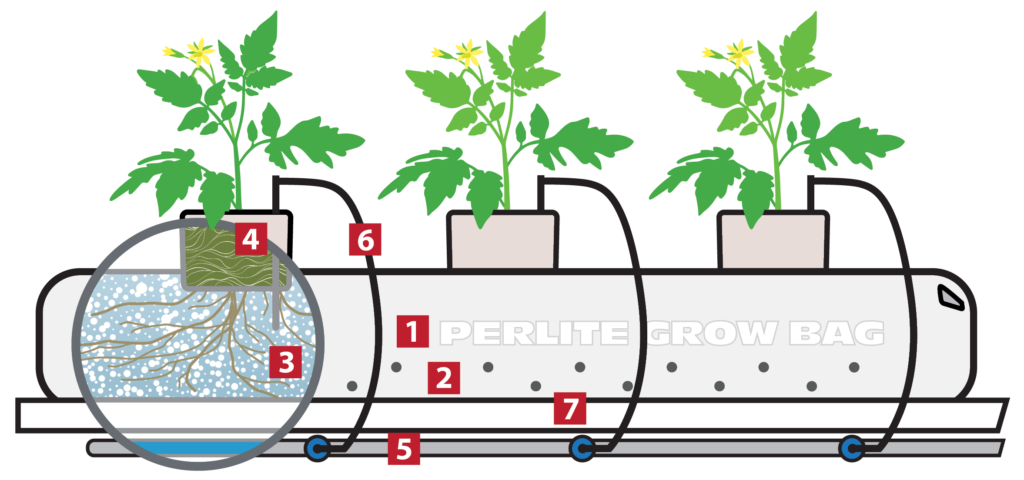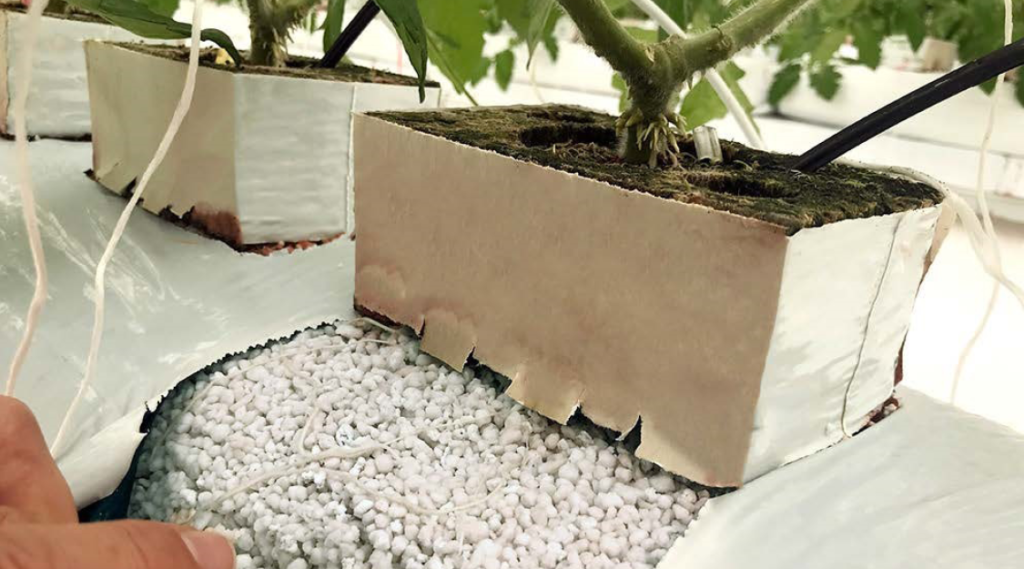For commercial growers considering containerized growing methods, perlite grow bags are self contained, quickly installed, and ready for immediate use.

Perlite grow bags are an easy-to-use, scalable, and cost effective solution for sustainable hydroponic crop production. They are very helpful for commercial farmers for scaling production, as perlite grow bags are easy to install and ready to use instantly. Additional sterilization and setting up processes, including soaking/wetting, are not necessary.
What Are Perlite Grow Bags?
Perlite grow bags are purpose-built packages constructed of dual-ply film with a dark inner liner that contain horticultural grade perlite and are designed specifically for use with hydroponic growing systems. Each bag is longer lengthwise which enables several plants to be grown together in the same unit. When laid end to end on a raised bench systems, they form organized, uniform rows which are easy to maintain, and conducive to air-flow for healthy growing conditions.
Why Use Perlite Grow Bags?
There are many reasons to consider perlite grow bags for your next project or installation. Perlite grow bags offer a number of competitive advantages over bags containing other growing media. They also help maximize the use of available space when compared with traditional forms of containerized growing.
For one, several plants share one bag, so the root systems spread out over a larger volume of substrate, increasing access to available air, water and nutrients.
When grown in conjunction with a controlled dosing system, plants receive the optimum level of air, water and plant-available nutrients leading to faster crop maturity, increased vegetation and fruiting, and lower maintenance costs.
Perlite is recognized worldwide as a preferred growing media for controlled environments. Expanded perlite is an inert, fully natural mineral, and completely sterilized during the expansion process. There is virtually no risk of contamination from soil-borne bacteria or other pathogens. Organic growing media, such as coir or peat can harbor fungi, bacteria or viruses which can be harmful to plant development, and will add costs to mitigate for their negative effects.

1 • Self-contained perlite grow bag unit.
2 • Pre-punched drainage holes.
3 • Sterile, horticultural-grade expanded perlite grow media provides generous volume for root growth and uptake.
4 • Seedling starter block or pot cut into the top of the bag.
5 • Nutrient-enriched water supply.
6 • Irrigation tubes.
7 • Support shelf and gutter drainage assembly.
Advantages of Perlite Grow Bags Over Alternatives
When choosing among the different hydroponic growing media, it is important to consider the
following:
- Ease of use
- Cost and availability
- Resource efficiency and waste

Perlite grow bags are lightweight and easy to install. They come ready to plant with very little labor required for setup as opposed to traditional bucket or containerized growing systems in which the perlite (or other soil media) must be measured out and dispensed into each container. With grow bags, this step is skipped and workers can go directly to planting.
Perlite offers both optimal capillarity and moisture-holding capacity while maintaining adequate porosity for aeration and drainage. These ensure an even distribution of mineralized nutrients, hygroscopic water, and oxygen levels for ideal root development. Other forms of hydroponic media do not offer the same balance of moisture to air ratios. Oftentimes, they must be hydrated first with large quantities of water before they can be used. Some, like coco coir, have the tendency to retain too much moisture and/or excess salts.
Further, coco coir (also known as coco peat), commonly ships as compressed bricks, which must be hydrated with large quantities of water prior to use, adding to lost time during installation and excess use of water.
Similarly, large amounts of water are necessary to hydrate rockwool prior to use. Adding this step adds to the time and complexity of an already complex setup process. Rockwool has an extremely high water-holding capacity, which causes the growing media to fluctuate between extreme moist conditions (just after watering) and too dry conditions (right before watering). Excess moisture and insufficient air-water balance leads to anaerobic conditions which can cause stunted growth or rotting.
From the standpoint of cost and availability, perlite has a clear advantage. Perlite is generally available locally by regional manufacturers who source their raw ore from deposits as close as possible to end users. This makes perlite a relatively sustain-able material since it is distributed throughout the world’s economic zones, and local manufacturers can use regional transport routes for supply and delivery.
Finally, perlite is a natural material with the ability to be reused several times. Keeping the growing media enclosed within the package helps retain moisture and keep it from evaporating. With the correct handling, perlite grow bags can be reused several times before needing to be replaced. When no longer viable for commercial use, they can be opened and dispensed and the perlite reused for other purposes. Alternatives, such as rockwool fibers, are not recyclable and must be disposed of in accordance with strict safety and ecologic regulations.
Harvest, Reuse and Recycle
After harvesting, perlite grow bags can be reused for an additional cycle (depending on the plant root type). Cleanup and discharge are also simplified. Perlite is easily repurposed for other agricultural uses, such as for landscaping applications or mixing with traditional potting media.
Perlite is a proven and widely used growing media which offers excellent value and high yields. Contact your local perlite manufacturer to learn how to switch to a natural mineral solution and benefit from improved performance and increased yields.

Overview of Using Perlite Grow Bags

Form Factor
Perlite grow bags arrive as self-contained units, ready for placement and immediate use.

Growth Process
Nutrient-rich water is introduced to each plant using drip irrigation.

Infrastructure
Perlite grow bags are laid horizontally on gutters or channels. Precut drainage holes in bags offer optimal drainage and moisture control.

Media Performance
The high capillarity of perlite growing media draws the correct amount of nutrient-rich water into the root zone.

Planting Process
Seedling containers are inserted into holes cut into the top of the bags. This offers the advantage of planting directly on the slab. In contrast to rockwool, there is no need for a second phase on a sheet.

Operational Process
Excess water drains easily, and is returned to the main reservoir to be recycled. Plants are staked or otherwise supported via typical methods.
Photos courtesy of Pull Rhenen b.v. (Netherlands), Gulf Perlite (U.A.E.), and Supreme Perlite (U.S.A.).
To download a .pdf of the Perlite Grow Bags brochure, click here.
If you have technical questions on this topic, please email the technical contacts listed on our contact page.
Copyright © 2022 Perlite Institute All Rights Reserved
